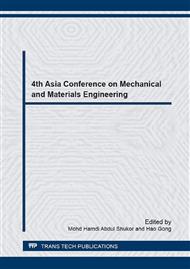p.29
p.33
p.37
p.41
p.45
p.50
p.54
p.59
p.63
Effect of Low Doses Gamma and Electron Irradiation on Mechanical Strength of Bi2Sr2CaCu2O8 (Bi-2212) Superconductor Ceramics
Abstract:
The effect of low doses of gamma and electron irradiation on mechanical strength of Bi2Sr2CaCu2O8 (Bi-2212) superconductor ceramics was studied by exposing the superconductor to gamma irradiation dose of up to 50 kGy, and electron irradiation dose of up to 80 kGy. All the samples were prepared using the conventional solid-state reaction method. For samples to be irradiated with electron particles, 5% weight percentage of nanosized MgO was added to absorb certain amount of the energy from electrons and thus reducing the formation of complicated defects structure in the Bi-2212 superconductor. The SEM micrographs of the Bi-2212 superconductor showed the existence of platelet-type grains of Bi-2212 phase in both non-irradiated and irradiated samples. The XRD patterns for the non-irradiated and irradiated samples showed well-defined peaks of which could be indexed on the basis of a Bi-2212 phase structure. The phase purity, lattice parameter, surface morphology and degree of crystallinity for the non-irradiated and irradiated samples were also compared and analyzed and it was found that both the gamma and electron irradiation have considerable effect on the mechanical properties of Bi-2212 superconductor. When subjected to gamma and electron irradiation, the microstructure of the samples was found to be more textured and consequently enhanced the strength of the samples.
Info:
Periodical:
Pages:
45-49
Citation:
Online since:
November 2016
Price:
Сopyright:
© 2017 Trans Tech Publications Ltd. All Rights Reserved
Share:
Citation:


